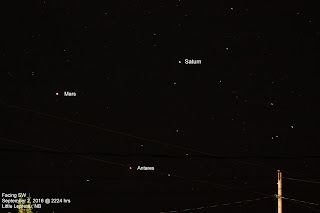Date Time: August 27, 2016 2030-2120 hrs
Weather: Partly cloudy, slight breeze to no wind, 17C and lots of mosquitoes. After midnight it dropped to 8C.
Attendance: Bobby Seely, Ed O'Reilly, David McCashion
Equipment: Eds 15x70 binoculars. My Canadian Telescopes 80 ED/APO mounted on a Vixen Alt/Az mount with a Camera adapter. Canon Rebel Xsi with 18-55mm and 75-300mm lenses, tripod.
Objective: To view and image a rare Venus/Jupiter Conjunction that was reported to happen just after sundown, very low in the west. 'Indeed, the 2016 Observer's Handbook of the Royal Astronomical Society of Canada notes that on Aug. 27, Venus and Jupiter will be in conjunction in right ascension at 2200 GMT (6 p.m. EDT), with Venus passing 0.1 degrees north of Jupiter. But that's not the moment when the two planets are closest to each other. According to Belgian astronomical calculator Jean Meeus, that moment will come 31 minutes later, at 2231 GMT (6:31 p.m. EDT). And the separation will be measured not in angular degrees but in arc minutes. Sixty arc minutes equals 1 degree. From eastern North America, the two planets will appear closest — separated by just 4 arc minutes, or 0.067 degrees (only about one-eighth the apparent width of the moon).'
Report:
- Shortly after arriving at the observing site, Venus was spotted low on the horizon just over the local paper mill. There were slow moving clouds near the bright 'star', threatening to block our view of it. The pairing was very close together, approximately 6 arc minuites apart and only 3 degrees above the horizon. We all seen Venus, but couldn't make out Jupiter easily. Bobby and I thought we could just barely make it out, but the pairing were easily split in the eyepiece of the camera and in Eds Binos. Bobby and Ed could see some of Jupiter's Moons but I couldn't see them through the camera view screen. Jupiter was much fainter than Venus and being so close to the horizon hurt the gas giants brightness.
- At approximately 2100 hrs the planetary pairing ducked behind a passing cloud. After this it peaked out once or twice for mere seconds at a time...and didnt appear again.
- After 2100 hrs the sky started to darken enough that Mars and Saturn were easily seen in the SW in Scorpius.
- No shooting stars or satellites were seen.
Images:
 |
| Camera with lens set at 75mm focal length, f/10, ISO 800, 1/6 second. |
 |
| Camera lens set to 150mm, F/10, 1/6 second, ISO 800. |
 |
| Camera attached to telescope at prime focus, Telescope F/6.25, 1/100 second, ISO 800 |
 |
| Camera lens set to 43mm, ISO 1600, 10 seconds, F/5. |
 |
| Camera lens set to 75mm, ISO 1600, F/4, 2 seconds. Image taken at 2109 hrs |
Note: A special thanks to BA Fenerty on the Royal Astronomical Society of Canada (RASC) Facebook webpage for bringing up the term Appulse. This refers to the moment in time where two planets pass very close to one another from another vantage point. Much rarer than a conjunction.
Facebook is a great wealth for sharing astronomy related images and experiences!




























